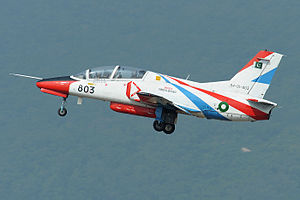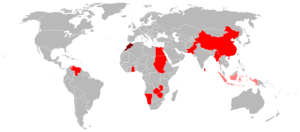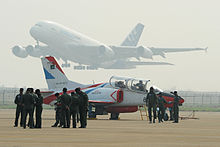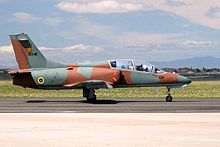Hongdu JL-8 Video - Picture

|
|
Hongdu JL-8
JL-8 K-8 Karakorum

Picture - A K-8 of the Pakistan Air Force aerobatics team, Sher Dils, takes off during the Zhuhai Air Show 2010 in China.
Role: Jet trainer
Light attack
Manufacturer: Hongdu
Pakistan Aeronautical Complex
First flight: 21 November, 1990
Introduced: 21 September 1994
Status: Operational
Primary users: PLA Air Force, Pakistan Air Force
Egyptian Air Force
Number built: 500+
Unit cost: 3 - 3.5 million $
The Hongdu JL-8 (or Nanchang JL-8), also known as the K-8 Karakorum, is a two-seat intermediate jet trainer and light attack aircraft built in joint-cooperation between the People's Republic of China (China Nanchang Aircraft Manufacturing Corporation) and Pakistan (Pakistan Aeronautical Complex). The contractor for this plane is the Hongdu Aviation Industry Corporation. Export versions are designated K-8 Karakorum, after the mountain range that separates China and Pakistan.
History
The K-8 trainer was built through joint cooperation between the governments of Pakistan and the People's Republic of China. Initially, the aircraft was to feature many United States parts, but due to political developments at the end of the 1980s (i.e. the Tiananmen Square protests of 1989), this plan was scrapped. The first prototype was built in 1989, with the first flight taking place on 21 November 1990.
The Pakistan Air Force (PAF) first received fourteen K-8 trainers in 1994, after which it decided to order 75 more to replace its fleet of Cessna T-37 Tweet trainers. The People's Liberation Army Air Force (PLAAF) received its first six K-8 trainers in 1998. Later upgrades to the Chinese model included an indigenously-manufactured Chinese engine. The PLAAF is anticipated to continue adding the trainer to its fleet in order to replace older trainers that are now obsolete, such as the Chengdu JJ-5.
Other nations have shown interest in the trainer and it now also serves in the air forces of Egypt, Sri Lanka and Zimbabwe. While the type primarily serves as a trainer, it can also be used in the close air support or even air combat role when appropriately armed.
The K-8 Karakorum-8 Basic Common Advanced Jet Trainer is co-developed by the Aircraft Manufacturing Factory (AMF), Pakistan Aeronautical Complex; and China National Aero-Technology Import & Export Corporation (CATIC). The Chinese designer of the aircraft was Mr. Shi Ping (ç³å±) and the chief test pilot was Mr. Yang Yao (æ¨è).
The latest development in the K-8 family is the K-8P version, which currently is operated by the PAF. The K-8P has an advanced avionics package of integrated head-up displays (HUDs) and multi-function displays (MFDs), also equipped with MFD-integrated GPS and ILS/TACAN systems.
In 2008 Venezuela announced the purchase of 18 K-8 aircraft. Currently the K-8 is being marketed by China to the air forces of the Philippines; and to Indonesia, as a replacement for Indonesia's BAE Hawk jet trainers. In 2009, the Bolivian government approved a deal to purchase 6 K-8P aircraft for use in anti-drug operations.
Design
The K-8 has a multi-role capability for training and, with little modification, can also be used for airfield defense. The aircraft is supposed to be as cost-effective as possible, with a short turn-around time and low maintenance requirements. Export variants of the K-8 (K-8E, K-8P) and domestic Chinese variants (JL-8) have differing powerplants and avionics configuration.
Airframe and flight control system
A low-wing monoplane design primarily constructed of aluminum alloys, the K-8 airframe structure is designed for an 8,000 flight hour service life.
The landing gear is of tricycle configuration, with hydraulically-operated wheel brakes and nose-wheel steering.
The flight control system operates a set of conventional flight control surfaces with a rigid push-rod transmission system, which itself is electrically- or hydraulically-operated. The aileron control system, of irreversible servo-control type, is composed of a hydraulic booster, an artificial-feel device, a feel trim actuator and a rigid push-rod transmission mechanism. The elevator and rudder control systems are of reversible push-rod type.
Cockpit and avionics
The cockpit arrangement is designed to be as close to that of a combat aircraft as possible. A transparent plastic canopy covering both cockpits, which are arranged in a tandem seating position, is supposed to give a good all-round field of view.
A Rockwell Collins Electronic Flight Instrument System (EFIS) is fitted, with multi-function displays (MFDs) in the front and rear cockpits showing information to the pilots. The emergency cockpit escape system is made up of two Martin-Baker MK-10L rocket-assisted ejection seats which are zero-zero capable, meaning they can be used safely at zero altitude and zero speed.
Ultra high frequency (UHF) and very high frequency (VHF) radio communication systems are present, along with a Tactical Air Navigation (TACAN) and automatic direction finder (ADF). An instrument landing system (ILS) is also available. These systems can be tailored to meet the requirements of the customer.
A strap-on Environmental control system (ECS) from AlliedSignal provides air conditioning to the cockpit. It is capable of operating when the aircraft is on the ground, under ambient temperatures of -40 to +52 °C, as well as in the air.
Propulsion and fuel system
The Chinese domestic variant of the K-8 (JL-8) was originally powered by the Ukrainian Ivchenko-Progress AI-25TLK turbofan jet engine, but this has been replaced by the WS-11, the Chinese-manufactured version of the AI-25TLK. Export variants (K-8P, K-8E) can be fitted with the more powerful and efficient Honeywell TFE731-2A-2A modular turbofan, which has digital electronic engine control (DEEC), if the US government approves sale of the engine to the customer.
A hydro-mechanical fuel control system delivers fuel to the engine. The aircraft's fuel system consists of the fuel tanks and the fuel supply/transfer, vent/pressurization, fuel quantity measuring/indicating, fuel refueling and fuel drain subsystems. The total fuel is contained in two fuselage bladder-type rubber tanks and a wing integral tank of 1720 lb. The capacity of each drop tank is 250 litres.
Operational history
The K-8 took part in its first aerial display to the Pakistani public on 6 April 2010 by the Sherdils (Lion Hearts) aerobatics team of the Pakistan Air Force. K-8 replaced the team's previous T-37 Tweet aircraft.
Variants
Data from: SinoDefence.com
K-8
Original variant powered by the Garrett TFE731-2A turbofan engine.
K-8E
K-8 variant developed for export to Egypt in 1999, featuring 33 modifications to the airframe and avionics. Built in Egypt from Chinese-supplied kits, production of 80 Egyptian-built Chinese kits was completed in 2005, with license production of an additional 40 K-8Es undertaken thereafter.
K-8P
Pakistan-specific variant with new avionics such as glass cockpit.
K-8V
An 'integrated flight test simulation aircraft' (IFTSA), equipped with an advanced flight control computer and analogue fly-by-wire (FBW) system which can mimic the aerodynamic characteristics and flight profile of other aircraft. Used primarily to test aircraft designs before prototypes are built and tested.
JL-8
PLAAF-specific variant powered by the Ivchenko AI-25 TLK turbofan and featuring Chinese avionics suite. First flew in December 1994, 6 aircraft delivered to PLAAF in June 1998.
L-11
Variant of JL-8 powered by the WS-11 turbofan (Ivchenko AI-25 TLK produced under license in China). Approximately 100 aircraft delivered to PLAAF.
JL-8W (K-8W)
Variant of the JL-8 with improved cockpit and HUD. Delivered to Venezuela's Bolivarian Military Aviation March 13, 2010, with no U.S.-controlled parts. Total order 18 aircraft (+ 40 announced).
JL-8VB (K-8VB)
Variant similar to JL-8W; for export to Bolivian Air Force, with no U.S.-controlled parts. Total order 6 aircraft (+ 12 announced).
Operators
The K-8 is China's most successful military aircraft that was exported in the last decade).

Picture - Operators of the JL-8 and K-8. Red = Current, Dark red = Former, Pink = Potential (Map last updated February 2008)
Current
Bolivia
Bolivian Air Force - 6 ordered, to be delivered in July 2011.
Egypt
Egyptian Air Force - 118(80 assembled from Chinese-supplied kits plus 40 manufactured in Egypt + 2 destroyed in training)
Ghana
Ghana Air Force - 4
Myanmar
Myanmar Armed Forces - 62
Namibia
Namibian Air Force - 12

Picture - A K-8 of the Pakistan Air Force aerobatics team, Sher Dils, at the airfield during the Zhuhai Air Show 2010.
Pakistan
Pakistan Air Force - ~22 K-8P, further deliveries scheduled. 6 K-8s powered by Honeywell TFE731 handed over to the PAF on 21 September 1994 for evaluation. 27 K-8Ps ordered in 2005, 16 delivered as of January 2009.
People's Republic of China
People's Liberation Army Air Force - 200
Sri Lanka
Sri Lanka Air Force - 6
Sudan
Sudanese Air Force - 12
Tanzania
Tanzanian Air Force - 6
Venezuela
Venezuelan Air Force - 6 delivered on March 13, 2010; 12 more before December 2011. In June 2010 it was announced that another 18 aircraft will be ordered to bring the total to 36. The last 23 August 2010 Venezuela has been received 12 K-8Ws to complete the first 18 ordered. One was lost shortly after takeoff on July 21, 2010 at Barquisimeto.
Zambia
Zambian Defence Force - 8

Picture - A K-8 Karakorum trainer of the Air Force of Zimbabwe at Ysterplaat Airshow, Cape Town.
Zimbabwe
Air Force of Zimbabwe - 12, 1 attritional loss
Specifications (K-8)
Data from Pakistan Aeronautical Complex, SinoDefence.com, PakDef.info, Jane's Aircraft Recognition Guide
General characteristics
Crew: 2 (in tandem)
Length: 11.6 m (38 ft 0 in)
Wingspan: 9.63 m (31 ft 7 in)
Height: 4.21 m (13 ft 9 in)
Empty weight: 2,687 kg (5,924 lb)
Max takeoff weight: 4,330 kg (9,546 lb)
Powerplant: 1x Garrett TFE731-2A-2A turbofan, 16.01 kN (3,600 lb)
Performance
Maximum speed: Mach 0.75 (800 km/h, 498 mph)
Range: 2,250 km (1,398 mi)
Service ceiling: 13,000 m (42,651 ft)
Wing loading: 254.40 kg m ()
Max. airframe load factor: +7.33 g / -3.0 g
Armament
Guns: 1x 23 mm cannon pod (mounted on centreline hardpoint)
Hardpoints: 5, total capacity 1,000 kg (2,205 lb) external fuel and ordnance:
4x under-wing, capacity 250 kg each
1x under-fuselage (23 mm cannon pod mount)
Rockets: 57 mm unguided rocket pods, capacity 12 rounds
Air-to-air missiles: PL-5, PL-7
Bombs: 200 kg, 250 kg unguided bomb, BL755 cluster bomb
Others:
2x fuel drop-tanks mounted on outboard under-wing hardpoints
Avionics
EFIS
Trainer (aircraft)
Jet trainer
Comparable aircraft
Aermacchi MB-339
Aero L-39 Albatros
BAE Hawk
Soko_G-4_Super_Galeb
HAL HJT-36 Sitara
Donald, David and Lake, Jon, ed. The Encyclopedia of World Military Aircraft (2000) p. 391-392. NY: Barnes & Noble. ISBN 0-7607-2208-0
Hongdu JL-8 Pictures
Living Warbirds: The best warbirds DVD series.
Source: WikiPedia